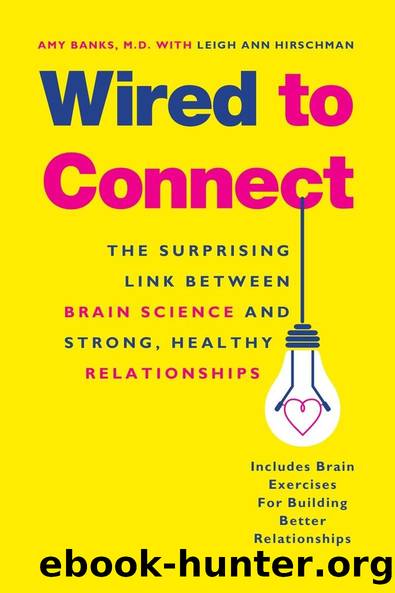Wired to Connect: The Surprising Link Between Brain Science and Strong, Healthy Relationships by Amy Banks & Leigh Ann Hirschman

Author:Amy Banks & Leigh Ann Hirschman [Banks, Amy & Hirschman, Leigh Ann]
Language: eng
Format: epub
Publisher: Penguin Publishing Group
Published: 2016-02-02T05:00:00+00:00
Try a Neurofeedback App
Iâve referred people with jittery sympathetic nervous systems to neurofeedback for years, but I didnât really understand the dramatic difference it can make in a personâs life and relationships until a member of my own family decided to try it.
Ben was a highly competent man, admired by friends and colleagues for his keen intellect and easy way with people. However, his family and friendsâand especially his partner, Aaron, knew him to be riddled with worry. Benâs sympathetic nervous system would fire, making him think that something dangerous was happening. He began to compile a mental list of dangerous things that could happen or that have happenedâand the next time his body alarm went off, the items from the list popped into his head, and he immediately had ten things to worry about. Nighttime was a silent hell for Ben; heâd wake up with his heart pounding and his mind grabbing on to the nearest negative thought as an explanation. Unfortunately, every once in a while, something bad did happen, which was just the intermittent reinforcement his body needed to convince itself to remain on high alert all the time.
Aaron had mostly grown accustomed to the way Benâs anxiety could hijack their lives. When they traveled, he knew to expect an extra fifteen minutes before they left a hotel room, because Ben obsessively double- and triple-checked under the beds and in the drawers for forgotten items. Aaron barely registered the way Ben followed the weather forecast before a trip and constantly predicted that an impending storm would prevent their departure. Most days, Aaron could also screen out Benâs repeated attempts to feel safe and in control of his emotions. At least once a week, however, Benâs anxiety would surge unpredictablyâand it seemed to suck the air out of the room. Aaron felt himself âcatchingâ the feeling. As Ben panicked, Aaron could feel his own chest tighten and his breath become shallow. In those moments, the only way for him to manage was to leave for an hour or so to clear his thoughts and feelings. Ben understood Aaronâs reaction cognitively, but each time Aaron walked away, Ben felt abandoned and judged. This chronic anxiety put them both in a no-win situation and undermined the relationship.
After his first neurofeedback treatment, Ben noticed a bounce in his step, and the rest of us, including Aaron, noticed that he was more communicative. After two weeks, his nighttime worrying had stopped, and even the daytime fears had greatly subsided. He radiated a brighter energyâand now Aaron âcaughtâ this better mood instead of Benâs anxiety. The impact was so profound that he and Aaron decided to rent a neurofeedback unit so Ben could hook himself up throughout the week.
Neurofeedback takes advantage of the rules of brain change to rewire the brain.
Your central nervous system communicates by electrical current; individual brain cells send messages throughout your brain and body by electrochemical reactions. With a highly sensitive meter, the amount of electrical current sent through your brain cells can be measured and monitored.
Download
This site does not store any files on its server. We only index and link to content provided by other sites. Please contact the content providers to delete copyright contents if any and email us, we'll remove relevant links or contents immediately.
Spare by Prince Harry The Duke of Sussex(5142)
Machine Learning at Scale with H2O by Gregory Keys | David Whiting(4260)
Fairy Tale by Stephen King(3308)
Will by Will Smith(2874)
The Bullet Journal Method by Ryder Carroll(2527)
Hooked: A Dark, Contemporary Romance (Never After Series) by Emily McIntire(2527)
Rationality by Steven Pinker(2329)
Can't Hurt Me: Master Your Mind and Defy the Odds - Clean Edition by David Goggins(2278)
It Starts With Us (It Ends with Us #2) by Colleen Hoover(2257)
Friends, Lovers, and the Big Terrible Thing by Matthew Perry(2184)
The Becoming by Nora Roberts(2155)
Love on the Brain by Ali Hazelwood(2026)
HBR's 10 Must Reads 2022 by Harvard Business Review(1822)
A Short History of War by Jeremy Black(1818)
The Strength In Our Scars by Bianca Sparacino(1818)
Leviathan Falls (The Expanse Book 9) by James S. A. Corey(1702)
A Game of Thrones (The Illustrated Edition) by George R. R. Martin(1665)
515945210 by Unknown(1644)
Bewilderment by Richard Powers(1583)
